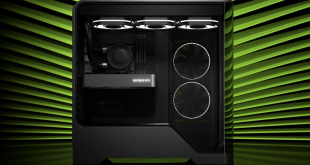
It's been a busy few weeks since Jensen Huang first announced the RTX 30-series in a live-streamed event from his kitchen. Last week saw the arrival of the RTX 3080, and today we are already moving on to look at the RTX 3090. While Nvidia specifically didn't call this their ‘flagship' GPU, it sits right at the top of the RTX 30-series stack, with a mammoth 10496 CUDA cores, 24GB GDDR6X memory and 350W TGP. This review is focusing on MSI's RTX 3090 Gaming X Trio model, priced at £1529.99.
Considering we reviewed the MSI RTX 3080 Gaming X Trio just last week, there may be a sense of déjà vu when looking at the RTX 3090 Gaming X Trio, as externally nothing appears to have changed. What has changed, is the configuration of the G102 GPU, so let's recap the core spec of this monster of a GPU.
| GPU | RTX 3090 | RTX 3080 | RTX 2080 Ti (FE) | RTX 2080 SUPER | RTX 2080 (FE) |
| SMs | 82 | 68 | 68 | 48 | 46 |
| CUDA Cores | 10496 | 8704 | 4352 | 3072 | 2944 |
| Tensor Cores | 328 | 272 | 544 | 384 | 368 |
| RT Cores | 82 | 68 | 68 | 48 | 46 |
| Texture Units | 328 | 272 | 272 | 192 | 184 |
| ROPs | 112 | 96 | 88 | 64 | 64 |
| GPU Boost Clock | 1695 MHz | 1710 MHz | 1635 MHz | 1815 MHz | 1800 MHz |
| Memory Data Rate | 19.5 Gbps | 19 Gbps | 14 Gbps | 15.5 Gbps | 14 Gbps |
| Total Video Memory | 24GB GDDR6X | 10GB GDDR6X | 11GB GDDR6 | 8GB GDDR6 | 8GB GDDR6 |
| Memory Interface | 384-bit | 320-bit | 352-bit | 256-bit | 256-bit |
| Memory Bandwidth | 936 GB/Sec | 760 GB/Sec | 616 GB/sec | 496.1 GB/sec | 448 GB/sec |
| TGP | 350W | 320W | 260W | 250W | 225W |
RTX 3090 uses the GA102 GPU, which also forms the basis for RTX 3080. Even with its 82 SMs, however, this is not actually a full implementation of GA102, as a fully populated die houses 84 SMs, so just two are missing from the RTX 3090. Ampere has doubled the number of FP32 shaders per SM, so there's a total of 128 CUDA Cores in each of those 82 SMs, for a grand total of 10496.
Each SM also houses a single RT Core, as well as four Tensor cores, giving us 328 with the RTX 3090. Additionally, there's 328 texture units and 112 ROPs.
As for the memory, this is a significant step up from the RTX 3080. RTX 3090 of course still uses GDDR6X memory, but it has over double the amount with 24GB. Additionally, the modules are clocked slightly faster at 19.5Gbps, and the memory interface is also slightly wider than RTX 3080, with a 384-bit interface. Total memory bandwidth comes in just shy of 1TB/s, hitting 936 GB/s.
Finally, we can see MSI has pushed the clock speed slightly further than reference. RTX 3090 defaults to a boost clock of 1695MHz, but MSI has added an extra 90MHz to this figure, bringing it up to 1785MHz. Later in the review we test exactly how fast this GPU actually operates, as we would expect GPU Boost to bring clock speed well above the rated speed.
 KitGuru KitGuru.net – Tech News | Hardware News | Hardware Reviews | IOS | Mobile | Gaming | Graphics Cards
KitGuru KitGuru.net – Tech News | Hardware News | Hardware Reviews | IOS | Mobile | Gaming | Graphics Cards



